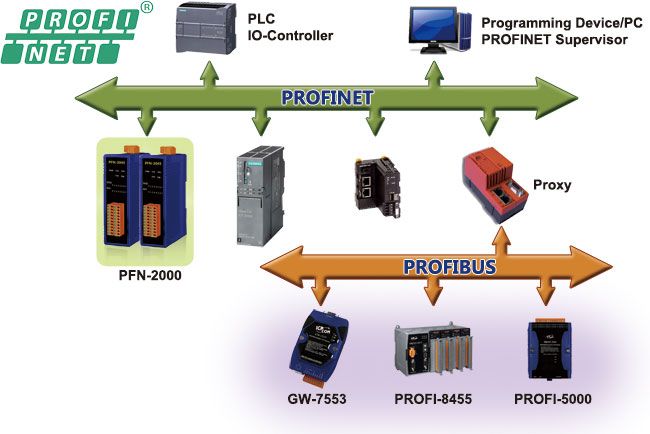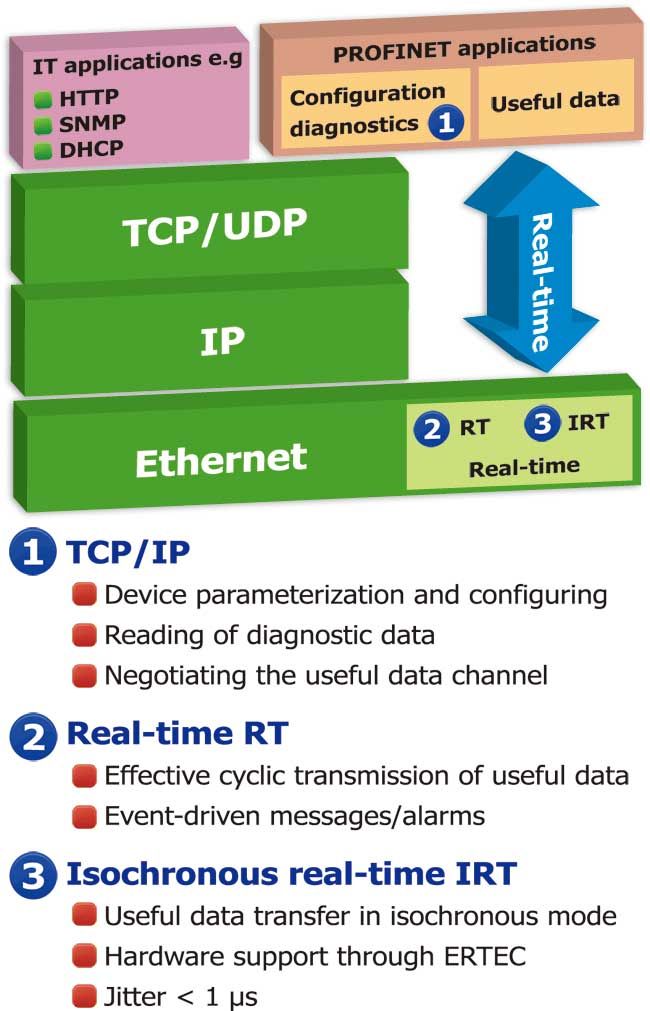PROFINET is an open Industrial Ethernet standard developed by the PROFIBUS Organization (PI). Based on Ethernet versatility, PROFINET make vertical integration of field level with Enterprise level easily. PROFINET is automation in real time, so it can cover all requirements of the Automation Industry. PROFINET is fit for factory automation, process automation, safety applications and motion control applications, etc.
PROFINET allows existing field bus systems such as PROFIBUS DP, PROFIBUS PA, AS-Interface, INTERBUS and DeviceNet to be integrated without changes to existing field devices. It means the investments of field devices and applications are all protected.

The PROFINET standard defines three different performance levels which cover the various requirements from different applications.
PROFINET NRT (Non Real Time): It uses standard protocols as UDP/IP. With response time approx. 100 ms PROFINET NRT targets for applications in process automation.
PROFINET RT (Real Time): For applications with higher requirements on cycle time like factory automation, it directly uses the Ethernet protocol to exchange I/O data, while diagnosis and configuration uses standard UDP/IP. PROFINET RT enables applications with response time approx. 10 ms.
PROFINET IRT (Isochronous Real Time): The highest requirements come from the control of complex industrial drive systems, like packaging machines or robotics. With applications with cycle time < 1 ms and jitter < 1 μs are possible.

Applications
- Industrial Automation
- Factory Automation
- Process Automation
- Etc…

Features
- Transfer protocol: PROFINET IO
- Supported Ethernet services: ICMP, IGMP, ARP, DHCP, TELNET, TFTP, SNMP, VLAN Priority Tagging
- Supported PROFINET services: RTC, RTA, CL-RPC, DCP, LLDP, I&M
- PROFINET Conformance Class B and RT Class 1
- Cyclic Time: 1ms (min)
- Generic GSDML File Provided
- Automatic MDI / MDI-X Crossover for Plug-and-play
|
|
|
| Model | Analog Input Modules |
|---|---|
| Module Name |
|
| Channels | 10 (Differential) |
| Sensor Type | Thermocouple (J, K, T, E, R, S, B, N, C) |
| Voltage Input Range | ±15 mV, ±50 mV, ±100 mV, ±500 mV, ±1 V, ±2.5 V, ±5 V, ±10 V |
| Current Input Range | ±20 mA, 0 ~ +20 mA, +4 mA ~ +20 mA (Jumper Selectable) |
| Resolution | 16-bit |
| Sampling Rate | 10 Hz |
| Accuracy | ±0.1% of FSR |
| EDS Protection | 4 kV Contact for each channel |
|
|
||
| Model | Analog Output Modules | |
|---|---|---|
| Module Name |
|
|
| Channels | 4 | |
| Voltage Output Range | 0 ~ 5 V, ±5 V, 0 ~ 10 V, ±10 V | |
| Current Output Range | 0 ~ 20 mA, 4 ~ 20 mA | |
| Resolution | 16-bit | |
| Accuracy | Voltage Output | ±0.1% of FSR |
| Current Output | ±0.1% of FSR | |
| ESD Protection | 4 kV Contact for each channel | |
|
|
||||||
| Model | Digital Input & Output Module | |||||
|---|---|---|---|---|---|---|
| Module Name |
|
|
|
|
|
|
| Digital Input | ||||||
| Channels | - | 16 | 8 | 16 | 8 | 6 |
| Contact | Dry + Wet | Wet | Dry | Dry + Wet | Dry + Wet | |
| Sink/Source (NPN/PNP) | Dry: Source Wet: Sink/Source |
Sink/Source | Source | Dry: Source Wet: Sink/Source |
Dry: Source Wet: Sink/Source |
|
| Wet Contact On Voltage Level | +10 ~ 50 VDC | +4 ~ 30 VDC | - | +10 ~ 50 VDC | +10 ~ 50 VDC | |
| Wet Contact Off Voltage Level | +4 VDC Max. | +1 VDC Max. | - | +4 VDC Max. | +4 VDC Max. | |
| Dry Contact On Voltage Level | Close to GND | - | Close to GND | Close to GND | Close to GND | |
| Dry Contact Off Voltage Level | Open | - | Open | Open | Open | |
| Input Impedance | 10 kΩ, 0.5 W | 3 KΩ, 0.3 W | 3 kΩ, 0.3 W | 10 kΩ, 0.5 W | 10 kΩ, 0.5 W | |
| Digital Output | ||||||
| Channels | 16 | - | - | - | 8 | 6 |
| Type | Open Collector | Open Collector | Power Relay | |||
| Sink/Source (NPN/PNP) | Sink | Sink | Form A | |||
| Load Voltage | +3.5 ~ +50 VDC | +3.5 ~ +50 VDC | 30 VDC/125 VAC | |||
| Max. Load Current | 700 mA/Channel | 700 mA/Channel | 2 A @ 30 VDC, 0.6 A @ 125 VAC |
|||
| Overvoltage Protection | 60 VDC | 60 VDC | - | |||
| Overload Protection | Yes | Yes | - | |||
| Power-on Value | Yes | Yes | Yes | |||
| Safe Value | Yes | Yes | Yes | |||


